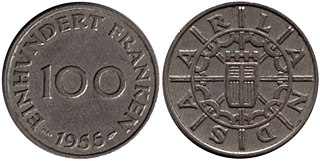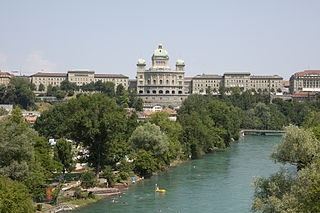
The franc is any of various units of currency. One franc is typically divided into 100 centimes. The name is said to derive from the Latin inscription francorum rex used on early French coins and until the 18th century, or from the French franc, meaning "frank".

The Department of the Treasury (USDT) is the national treasury and finance department of the federal government of the United States, where it serves as an executive department. The department oversees the Bureau of Engraving and Printing and the U.S. Mint. These two agencies are responsible for printing all paper currency and minting coins, while the treasury executes currency circulation in the domestic fiscal system. It collects all federal taxes through the Internal Revenue Service; manages U.S. government debt instruments; licenses and supervises banks and thrift institutions; and advises the legislative and executive branches on matters of fiscal policy. The department is administered by the secretary of the treasury, who is a member of the Cabinet. The treasurer of the United States has limited statutory duties, but advises the Secretary on various matters such as coinage and currency production. Signatures of both officials appear on all Federal Reserve notes.

The 26 cantons of Switzerland are the member states of the Swiss Confederation. The nucleus of the Swiss Confederacy in the form of the first three confederate allies used to be referred to as the Waldstätte. Two important periods in the development of the Old Swiss Confederacy are summarized by the terms Acht Orte and Dreizehn Orte.

The United States Mint is a bureau of the Department of the Treasury responsible for producing coinage for the United States to conduct its trade and commerce, as well as controlling the movement of bullion. The U.S. Mint is one of two U.S. agencies that manufactures physical money. The other is the Bureau of Engraving and Printing, which prints paper currency. The first United States Mint was created in Philadelphia in 1792, and soon joined by other centers, whose coins were identified by their own mint marks. There are currently four active coin-producing mints: Philadelphia, Denver, San Francisco, and West Point.

The Swiss franc, or simply the franc, is the currency and legal tender of Switzerland and Liechtenstein. It is also legal tender in the Italian exclave of Campione d'Italia which is surrounded by Swiss territory. The Swiss National Bank (SNB) issues banknotes and the federal mint Swissmint issues coins.

A mint is an industrial facility which manufactures coins that can be used as currency.

The Federal Department of Finance is one of the seven departments of the Swiss federal government. The department is headquartered in Bern and headed by a member of the Swiss Federal Council, Switzerland's finance minister. Initially, in 1848, the department was called "Department of Finance", then, from 1873 "Department of Finance and Customs", until it received its present designation in 1978.

The Royal Australian Mint is the national mint of Australia, and the primary production facility for the country’s circulating coins. The mint is a Commonwealth Government entity operating within the portfolio of the Treasury, and is situated in the Australian capital city of Canberra, in the suburb of Deakin. The current facility was opened in 1965 by Prince Philip, Duke of Edinburgh.

The Federal Palace is a building in Bern housing the Swiss Federal Assembly (legislature) and the Federal Council (executive). It is the seat of the government of Switzerland and parliament of the country. The building is a listed symmetrical complex just over 300 metres (980 ft) long. It is considered one of the most important historic buildings in the country and listed in the Swiss Inventory of Cultural Assets of National Importance. It consists of three interconnected buildings in the southwest of Bern's old city. The two chambers of the Federal Assembly, the National Council and Council of States, meet in the parliament building on Bundesplatz.
A branch mint is a satellite operation of (usually) a national mint. In many cases it will add a mint mark to coins that is different from that used at the main facility, although each country has different rules that may vary over time. Added letters are shown below for the United States, France and Switzerland. Because of this difference, coins produced at branch mints may be worth more or less to collectors than those from the main one, depending on their mintages.

Vreneli is the informal name for a range of legal tender gold coins of the Swiss franc. The coins were issued between 1897 and 1936, in 1947 and in 1949. All coins issued after 1936 are restrikes.

The Swiss Agency for Development and Cooperation (SDC) is an office-level agency in the federal administration of Switzerland, and a part of the Federal Department of Foreign Affairs. Together with other federal offices, SDC is responsible for overall coordination of Swiss international development activities and cooperation with Eastern Europe, as well as humanitarian aid.

Swiss Post is the national postal service of Switzerland. A public company owned by the Swiss Confederation, it is the country's second largest employer with about 54,000 employees. The group is based in Bern and has branches in 25 countries. Roberto Cirillo is its CEO since April 2019. In 2021, Swiss Post was ranked as the world's best by the Universal Postal Union for the fifth time in a row. In December 2022, it was announced Swiss Post has acquired the St. Gallen-based sustainable packaging company, Kickbag GmbH.

The Japan Mint is an Independent Administrative Institution of the Japanese government, responsible for producing and circulating the coins of Japan. The agency has its head office in Osaka with branches in Saitama and Hiroshima. The Japan Mint does not produce paper money; that responsibility belongs to the National Printing Bureau.

The federal administration of Switzerland is the ensemble of agencies that constitute, together with the Swiss Federal Council, the executive branch of the Swiss federal authorities. The administration is charged with executing federal law and preparing draft laws and policy for the Federal Council and the Federal Assembly.

The Swiss Graduate School of Public Administration is a Swiss graduate school of public administration. In 2014, the independent foundation was integrated into the University of Lausanne.

The coins of the Swiss franc are the official coins used in Switzerland and Liechtenstein. The name of the subunit is centime in French and internationally, Rappen in German, centesimo in Italian, and rap in Romansh. There are coins in denominations of 5 centimes, 10 centimes, 20 centimes, 1⁄2 franc, 1 franc, 2 francs, and 5 francs.

A shooting thaler is a silver coin in thaler size minted to commemorate a Schützenfest or free shooting in Switzerland.

Gottfried Keller-Stiftung, commonly abbreviated to GKS, is an arts foundation focused on cultural heritage of Switzerland. It was named by its founder Lydia Welti-Escher (1858–1891) after the Swiss national poet Gottfried Keller (1819–1891).

The Federal Finance Administration (FFA) (German: Eidgenössische Finanzverwaltung, EFV, French: Administration fédérale des finances, AFF, Italian: Amministrazione federale delle finanze, AFF) is the Swiss federal office responsible for drawing up the Confederation's budget, financial plan and accounts, managing its treasury, and for the financial equalization between the Confederation and the cantons. It is subordinated to the Swiss Federal Department of Finance.


















